For the last two weeks, I've been testing two drum carders: the Patrick Green Deb's Delicate Deluxe, and the Strauch Finest. This is my comprehensive review of the two.
Let's start with the basics. Both of these are really great carders. I would not say no if offered either one, and if one was for some reason not available, I would happily choose the other. That said, like all engineered products, each one is the result of a series of design decisions, and those decisions gave me a rung to hang my preference hat onto, as it were.
I ran these carders through a series of tests designed to compare their design and performance. These were things that were important to me, things that were important to other people, and some things that turned out to not be that important at all. Here are some quick links to take you to each of the tests:
Features and Accessories
Ease of Use: Handle
Ease of Use: Batt Removal
Design: Drive Belts
Design: Clamps
Design: Licker-In
Design: Carding Drum
Effectiveness: Batt Size
Effectiveness: Removal of VM
Cleaning
Summary
| Patrick Green Deb's Delicate Deluxe | Strauch Finest | |
| price: | $525 | $695 |
| gear ratio: | 30:1 | 5:1 |
| upgrade motor available: | no | yes |
| cost for motor: | $1550 for "Fancicard" model | $1150 for upgrade kit; $1724 for motorized version |
| included tools: | Clamps, cleaning brush, doffer stick | Knuckle-saver batt picker, doffer brush, clamps, cleaning brush, Strauch teasing tool |
| drum fabric: | "fur" included, "production" available separately | 128 tpi |
| drive band: | poly | chain |
Overall, I would say the carders are about equal on features. They both came with enough tools to do the job, and while the Patrick Green cannot be upgraded to take a motor, the cost of the motorized version is less than that of the motorized Strauch, and resale value on carders is actually pretty good.
There were two standouts in the area of ease of use, and interestingly they were both really strongly tilted away from one of the carders. The first one was the handle for turning the drum.
This is the handle on the Patrick Green:
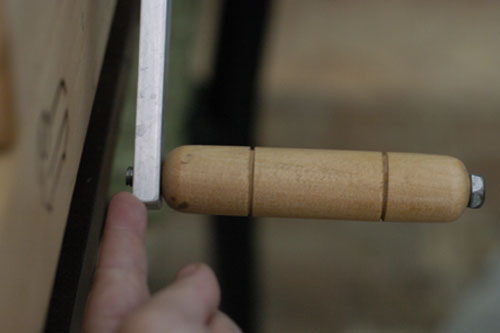
It's a metal bolt that screws into the metal arm very nicely, with a wooden handle slipped over it. The only issue is that it tends to unscrew itself as you turn the handle, unless you hold it very very loosely (and even then it only unscrews itself more slowly). There was no nut or other holder to keep it attached against the movement. Edited to add: the carder apparently comes with a locking nut for the handle which was missing on the carder I used; I was dealing with just a plain machine nut that unscrewed itself, which was a replacement for the original nut. I still liked the Strauch handle better, though let's give some points to the Patrick Green on a nice solid wooden handle that is easy to grip.
The Strauch handle, on the other hand, did not suffer from this affliction. It's not as fancy a handle -- indeed, in comparison it feels almost flimsy -- but it has a solidity to it and definitely was not detaching itself from the arm.
In addition, the handle on the Patrick Green rotates down below the bottom of the carder, so it must sit at the edge of a table. The Strauch is designed so you can turn the handle with the carder in any position on the table. It turns out that I usually kept both carders right at the edge of the table, but the real utility of the handle turning from any position was when I was cleaning up; you do a lot of lifting and flipping and turning, and being able to do that in any position was priceless.
In terms of the handle, the Strauch is the hands-down winner for ease of use.
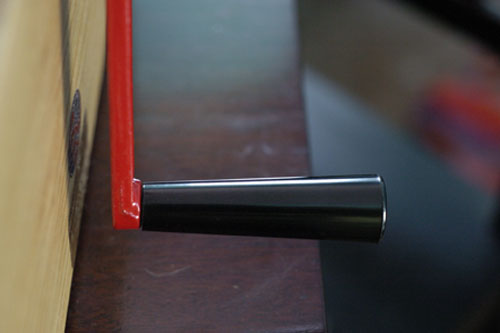
BUT, let's talk carding cloth and the ease of removing the batt from the drum. I did a series of tests on removing batts from the drums of both carders, first with no outside assistance, then with a hand carder, then with the Strauch knuckle-saving batt picker tool. In all cases the Patrick Green carder gave up the batt more cleanly and with less fuss and hassle. Here's a batt coming off the Patrick Green, with no assistance at all:
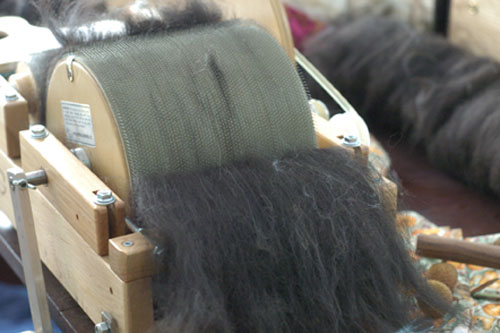
And here's one clinging tightly to the Strauch despite much encouragement on my part:
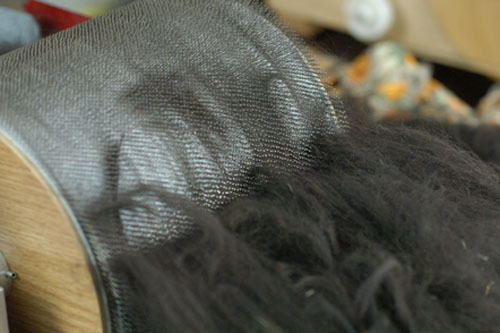
What I eventually found worked best was to not try to get all the fiber off the drum on the Strauch; if I left a thin layer of fiber on the drum then subsequent batts were easier to remove, and the batt I did get off was smoother and nicer to handle. That's less than ideal, but works well if you're doing a lot of batts of the same colours. For me, the Patrick Green was hands-down the winner in terms of batt removal.
One of the major differences between the Patrick Green and the Strauch is the belt material. I think, from reading other people talking about these carders, that belt material is a preference thing. The Patrick Green has what I think is a polyurethane drive band:
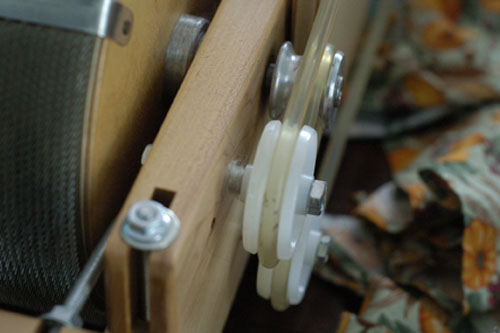
While the Strauch has a chain drive:
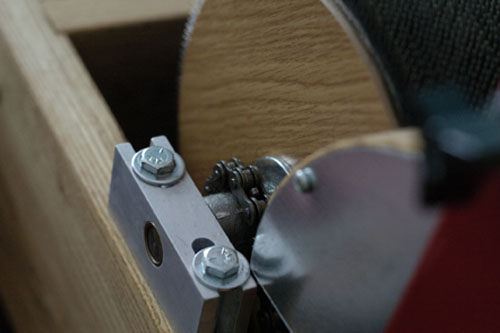
For me, I found the chain drive tended to get mucked up with fiber, and was harder to clean. But I can definitely see the durability benefits, and you're just not going to break a chain on a drum carder, whereas eventually the poly drive band will break. On the other hand, the poly drive bands cost under $20, and they last for years.
For me, it came down to the cleaning thing: I like the poly band better because it was a lot easier to clean it.
Another design choice I found interesting was the integrated clamps on the Patrick Green. The Strauch, you will recall, has clamps included but does not require them; you can set the thing in the middle of the table and work there with no difficulty. The Patrick Green's handle rotation requires you to set it up on the edge of the table, and I found the carder was light enough that you really did want to have the clamps engaged, or it would skitter around.
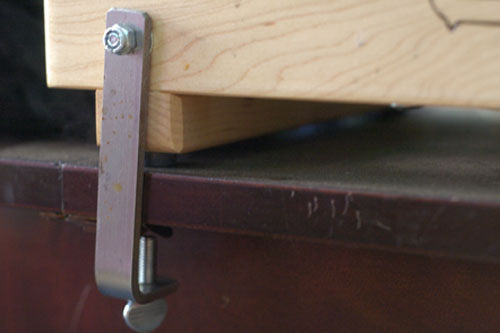
Given the need to clamp the carder down, I liked how the Patrick Green clamps were bolted on. I think this makes it less likely that you will lose the clamps and render the carder less usable. As a case in point, the person who lent me the Strauch didn't bring along the clamps because she'd mislaid them somewhere. On the other hand, I never felt the need for them.
A huge difference between the two carders was the licker-in material. On the Patrick Green, the licker-in is made of spirally-wrapped carding cloth. There's no gap where the cloth joins together, and it never meets end-to-end. There is a small gap where the spiral ends.
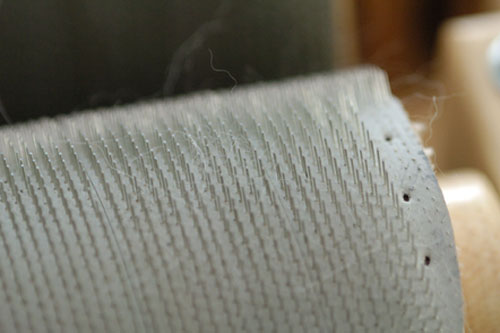
The Strauch, on the other hand, has this utterly terrifying cloth made of tiny blades, looking much like the sorts of weird sculptures my architecture classmates would make during late nights in studio. You can seriously hurt yourself on this.
It also, you will notice, has a seam where the two ends of the cloth come together, leaving a gap. To be honest, I didn't find that to be an issue in using the carder, though I did find the blades were an issue when I was cleaning it, because it definitely upped the ante on squeezing fingers into the mechanism.
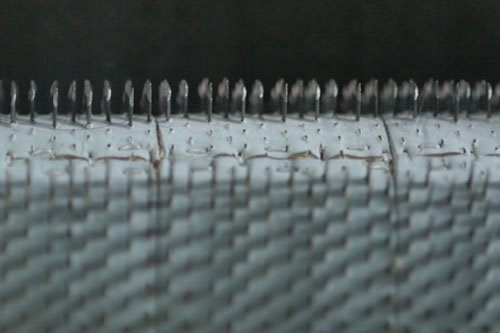
The last real design difference between the carders was in the seam in the carding cloth in the main drum. You need a seam somewhere to make it possible to get a doffer stick in (or a butter knife, in my case) to lift the batt from the drum. I really liked the approach Patrick Green took, which is a nice stainless steel bar covering the seam. It was easy to get the doffer in there to lift the batt, and you didn't snag on anything.
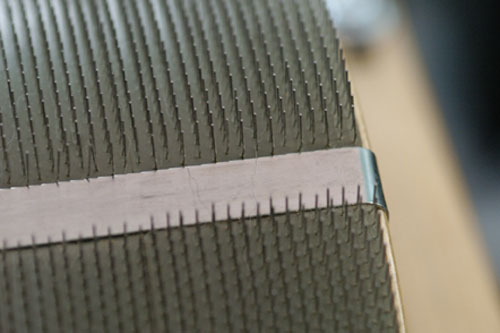
The Strauch has a band of material across the seam, and it does the trick, but I did find that the doffer would get snagged on the staples there as I moved it across the batt.
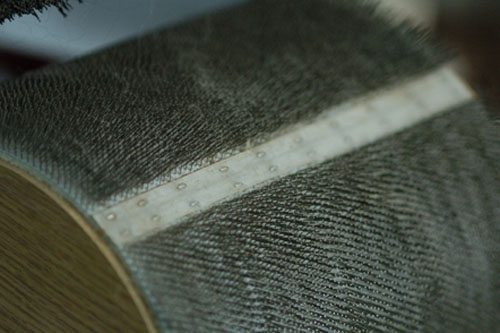
Of course, that's no reason to choose one carder over the other; if you really liked the stainless bar, it's pretty trivial to put one onto the Strauch without making any sacrifices.
Overall, I liked the cloth on the main drum of the Patrick Green better than the cloth on the main drum of the Strauch. I think that's a personal preference thing.
I carded some 2nd cut alpaca into three batts each on the two carders, then weighed the batts to determine which carder could fit more on its drum. I used the brush attachment on the Finest to pack more fiber onto the drum, and the burnishing tool included with the Deb's Deluxe for the same purpose. The brush attachment was certainly easier to use than the burnishing tool, but I found the burnishing tool gave me a batt with a texture I liked better on both carders. I would advise foregoing the brush attachment and just buying a burnishing tool if you go with the Strauch. Susan's Fiber Shop sells the burnishing tool separately for $55
Here's the Patrick Green fully loaded with fiber:
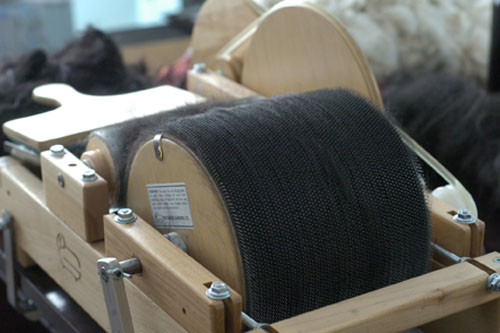
And the Strauch:
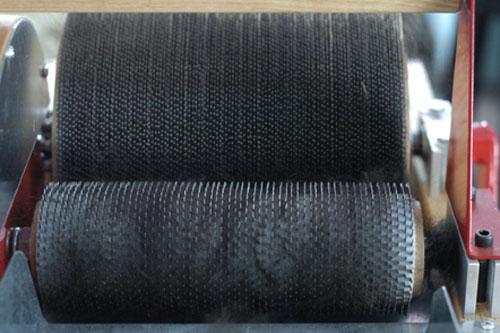
I could have gotten more fiber onto both carders by cramming it down with the burnishing tool, but in both cases I added fiber until I felt like the carder was resisting having more fiber added.
I ended up with this:
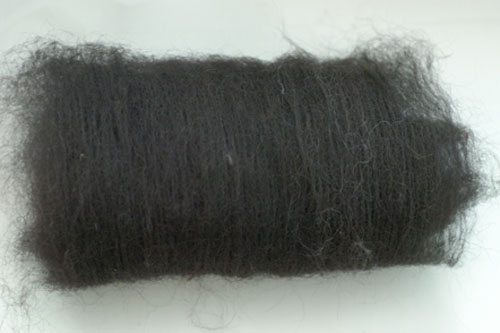
The Deb's Deluxe batts weighed 1.0, 1.0, and 0.9 oz. The Finest batts weighed 1.0, 0.8, and 1.1 oz. So both carders made batts averaging out to the same weight (0.97 oz. for this alpaca).
Here are some batts: the Patrick Green batts are at the top, and one Strauch batt is on the bottom. Both carders were able to produce pretty much the same batt size and shape.
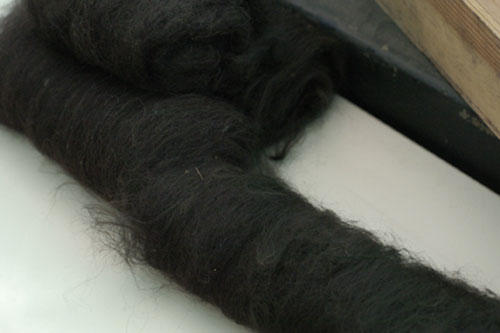
In general, I felt like the batt I got out of the Patrick Green was good and usable with one carding. I always did two times through on the Strauch; sometimes I felt like a third time was required. But the best batts were the ones I carded twice on the Strauch, and then a last time on the Patrick Green. Yes, I do realize that that's an unrealistic scenario, but it actually costs less than a motorized carder from either maker.
One thing many people told me about a drum carder, and which I didn't totally believe, is that you can use it to get vegetable matter (VM) out of your fiber. As a test, I used alpaca with a normal amount of VM for alpaca, and fed about the same amount of VM-filled fiber into each carder. Both carders got quite a bit of it out, which was somewhat unexpected.
The Patrick Green left a substantial pile of chaff underneath, and also threw some out the back:
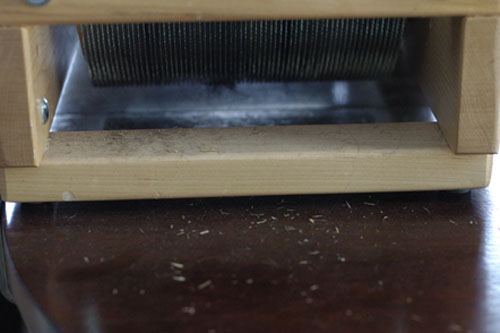
While the Strauch generally confined its chaff to the underside of the carder, but likewise did a decent job of removing VM.
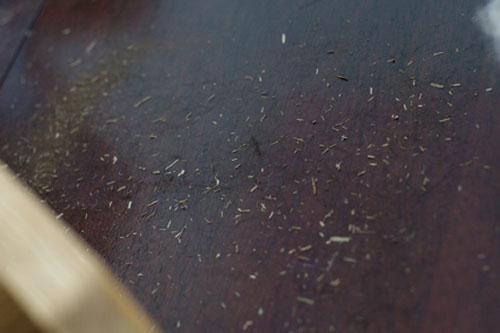
I would call it a tie on this feature. Both carders removed quite a bit more VM than I expected, and I would say at about the same rate.
Also, I would say that a carder is a stupid tool to use for removing VM. It works, but if you have a lot of stuff in your fiber you'd be better off just making or buying a picker and using that first. That, or picking out and throwing away the worst balls of clumped up fiber and VM.
I made a total mess of both carders, then set out to clean them. Cleaning is a huge part of owning a carder, and I wanted to be sure to include that in this comparison.
Here's the Patrick Green after a massive carding session, about as messy as it got:
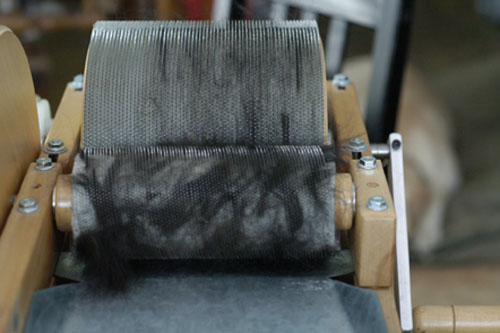
A few more turns of the handle and the licker-in would pass off that extra fiber to the drum, mostly cleaning itself off.
The Strauch, on the other hand, tendded to hold onto the fiber more tenaciously:
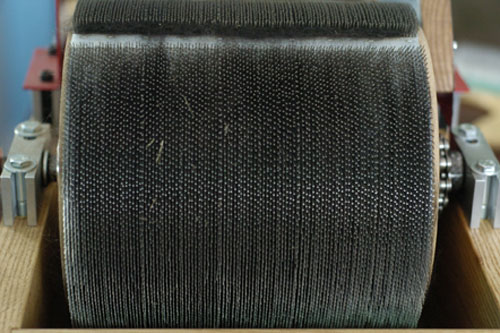
And here's the licker-in on the Strauch after the massive carding session:
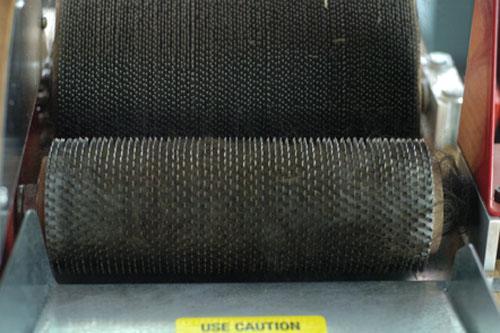
You might notice that that picture looks an awful lot like the fully loaded Strauch. This was my pet peeve about that carder. What I found was that the Strauch just tended to have a lot more fiber on it to clean up. You can see here that the drum on the Strauch had a lot of fiber left on it (see my earlier comments about removing the batts from the drum), so there was just more to clean up. I also found that the licker-in tended to accumulate more fiber than I would have expected.
In fact, using the cleaning flicker, I removed about half an ounce of fiber from the main drum. It looked pretty good, so I added it to some other fiber and sent it through the Patrick Green, ending up with a very nicely carded batt. With that pulled off, I still had more fiber to clean off the main drum and licker-in.
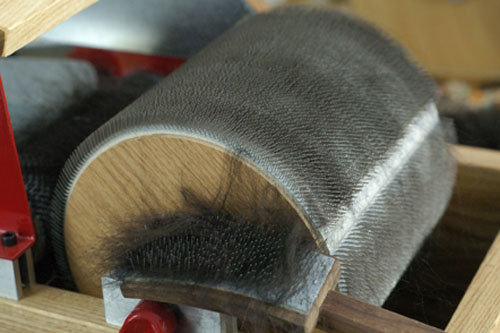
What was left behind was waste fiber. The real comparison is here: on the right you have the waste fiber from cleaning up the Patrick Green. On the right you have the waste fiber from cleaning up the Strauch. There's 2 to 3 times as much junk from the Strauch. Not a huge amount, of course, but it did give me something to consider.
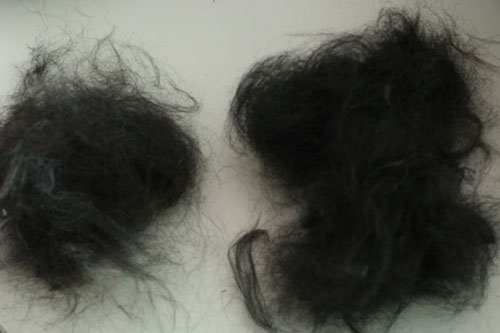
The other aspect of cleaning that was Not Fun was getting the fiber out of the axles of the carders. In this case again the Patrick Green was a bit less of a mess to begin with than the Strauch. Here's the fiber buildup after five batts on the Patrick Green:
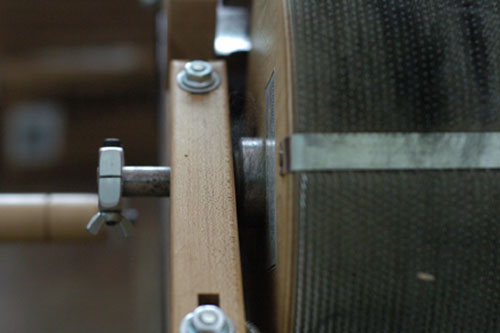
And after the same number of batts on the Strauch:
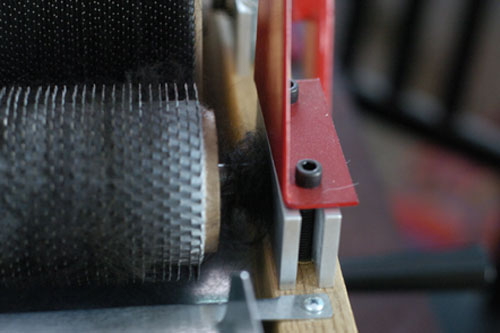
It seemed like a huge amount of fiber would get wound around the licker-in axle and coated in grease. And let's not even talk about the fun of picking fiber out of the chain drive. Blech. Though I will say that it was much easier to get into the axle on the Strauch and get the fiber out; to get down to the axle on the Patrick Green required a pair of long tweezers. But watch your hands with those evil blades on the Strauch.
For both carders, cleaning was considerably easier if I just gave in and removed the drums to clean the fiber out. That requires aligning the drums again when you put them back in, so have care if you do that.
| Patrick Green | Strauch | |
| Features and Accessories | good price, good accessories | decent price, great accessories |
| Ease of Use: Handle | boo! | yay! |
| Ease of Use: Batt Removal | yay! | boo! |
| Design: Drive Belts | yay! | meh |
| Design: Clamps | meh | meh |
| Design: Licker-In | yay! | yay! |
| Design: Carding Drum | yay! | boo! |
| Effectiveness: Batt Size | yay! | yay! |
| Effectiveness: Removal of VM | yay! | yay! |
| Cleaning | yay! | meh |
After testing these two carders for two weeks, I made a decision about what I want. I'm going to end up with a motorized carder from Patrick Green. For what is important to me, that is the carder I want. It's going to end up costing almost three times as much as I was expecting, but it turns out that the motor is a lot more important to me than I expected.
This is not to say that the Strauch sucks. It's a mighty fine carder, and I'd be happy to have one. The person I respect most on the world on the subject of fiber prep, Abby Franquemont, uses a Strauch. I suspect that she doesn't have half the trouble I've had removing batts from her carder. But, you know, you have to buy tools for yourself, not for an expert in the field. So I'll be buying a Patrick Green. When, you know, that Other Thing that is sucking up all our money for the time being is over.

I was just introduced to a Strauch Finest this past weekend when a friend brought one over for me to play with. Her technique for removing the batt from the carder was to use a hand carder to sort of push the batt down and off, and it got most if not all of the fiber off of the carder. Just a suggestion from a first-timer!
Great comparison -- very thorough. I often get asked about these two, and haven't had the opportunity to play with a Deb's Deluxe (just a Supercarder, which *really* isn't a fair comparison).
One tip in general on carding I can offer you, on batt removal: I find I get more off the machine if I roll the batt up tight (usually I start with a dowel or empty paper towel tube at the top, to provide a "core" to wrap around initially and to hang onto), keeping it against the drum as I roll. Now, you're carding alpaca, which is slicker than the wool I typically card, so it may be harder to get off cleanly. But I have seen a difference, between simply lifting a batt off the drum and this rolling-it-up-while-keeping-the-roll-against-the-drum method I use now. Which way were you doing it? I'd be interested to know.
Thanks again for the great comparison. This is as helpful as the digital camera comparisons I poured through choosing my new one :-)
Amelia (and Mardi), I tried unrolling a batt from the drum onto a core (a chopstick, then a fat dowel; I didn't have any paper towel tubes), I also tried using a carder to help it off the drum. And easing it off by hand, and using the little flicker that came with the Strauch, and using the batt picker that came with the Strauch. I made about 30 batts, each carded at least twice, so I had a lot of practise.
It's interesting to hear that alpaca might just be harder to get off the drum. I have the Strauch for a few more days so maybe I will try carding some wool on it and see how that goes.
I loved your review and thought you did a great job!!!
I do have a point about the handle. The handle should have come with a locking nut that goes on the inside of the screw for the handle. When that is in place, the handle does not get loose. It might have fallen off in shipping and is in the box. That would solve the loose handle problem.
Thanks for doing such good research on the carders!
Thanks, Deb! I did wonder about the handle, because the rest of the carder was so well thought out. There was a nut on the inside of the screw, but it was not a locking one, so I suspect the owner lost the original at some point and replaced it. The perils of using other people's equipment, I guess.
I have a Strauch Finest, and have no problems getting the batt off completely cleanly. I use a Schacht 208-tpi cotton card, which is wide enough to get the width of the drum in one pass. I sort of "roll" from the handle of the carder to the tip, while turning the drum, and the fiber swoops right off. When I get to the top of the carder, I disengage it from the batt and repeat until I've gone all the way around the drum. I don't drag the carder at all, just use it to lift the batt.
I've also never had any fiber at all build up on the licker-in. Maybe you're trying to put through too much at once?
HI, I am very interested to know if anyone can tell me which drum carder is best for carding angora rabbit fibre. I live in Australia and have been looking at a patrick green or strauch and am leaning towards a patrick green after reading this review but as its pretty expensive to ship one out to australia I want to get it right. has anyone tested carders using angora rabbit fibre, thankyou in advance for any advice regards Maree Hamming in Tasmania australia
I rented a Deb's Delicate Deluxe from our local weaving guild and love it! We are carding alpaca, merino, silk, cashmere & qiviut on it with very few problems. Our handle came with a jam nut, which my husband put on, and the handle never comes off.
I use a bamboo placemat to remove my batts. It does seem to get more fiber off than when I just pull it of by hand. I use the doffer to start with, then I fold this initial fiber over the edge of the placemat and then start rolling. I too, roll it right against the large drum as I am rolling it off.
Interesting blog entry, thanks for publishing all that comparison! I bought the Strauch Petite which is not as heavy duty as the Finest, granted. But I got close to an ounce on that (with room to go) and had no trouble removing the batt, and zero contact between fiber and drive belt or axle, with nothing left on the lickerin. The one biggie tip that I listened to, however (and I'm convinced it's key) is to feed in fiber at a thin enough rate so you can definitely see through it on your feed-in tray. I cheated a couple of times (once unintentionally) and not only did it slow things down, but gave me fiber on the lickerin. That's when I got some waste. I got zero waste otherwise, however. I really think the amount of fiber going in truly makes a big diff.
Great photos, and a terrific review! I'm going to try the trick with the paper towel core, except will offer that a super neat core (really sturdy) is from a roll of plastic wrap. Those suckers will last!
Hi. Thanks SO much for the thorough review. I just missed out on buying a PG carder a friend was selling (didn't want to spend the $ at the time) so am now researching others. This was a BIG help.
If cost were not an issue, would you choose PG happy hybrid or the fancicard? Thanks for a fantastic comparison - even my husband was impressed. Nirelle
Nirelle, I don't really know much about any other carders than the one I tested, but Pat Green generally uses the same drums on their carders, and their drums are fantastic. Since I have decided that a motorized carder is not a luxury but a requirement for me, my husband suggested I get the manual version and he would motorize it. If you have the mechanical and electronic know-how, motorizing any carder is trivial (especially the Pat Green carders, because the crank arms are metal). Otherwise I would choose a motorized one.
Also, if you call Pat Green, they will happily talk to you about your needs and what they have on offer to meet those needs.
What a great review. Thanks so much. I knowthis is several years old, but I'm in the market for a drum carder. I was wondering if you have had any experience with a Fancy-Kitty, which is the other one I'm considering in addition to the 2 you reviewed.
I have no personal experience with the Fancy Kitty but I know a couple people who own them and are quite happy with them. They do not do much carding (personal use only; they're not selling batts).